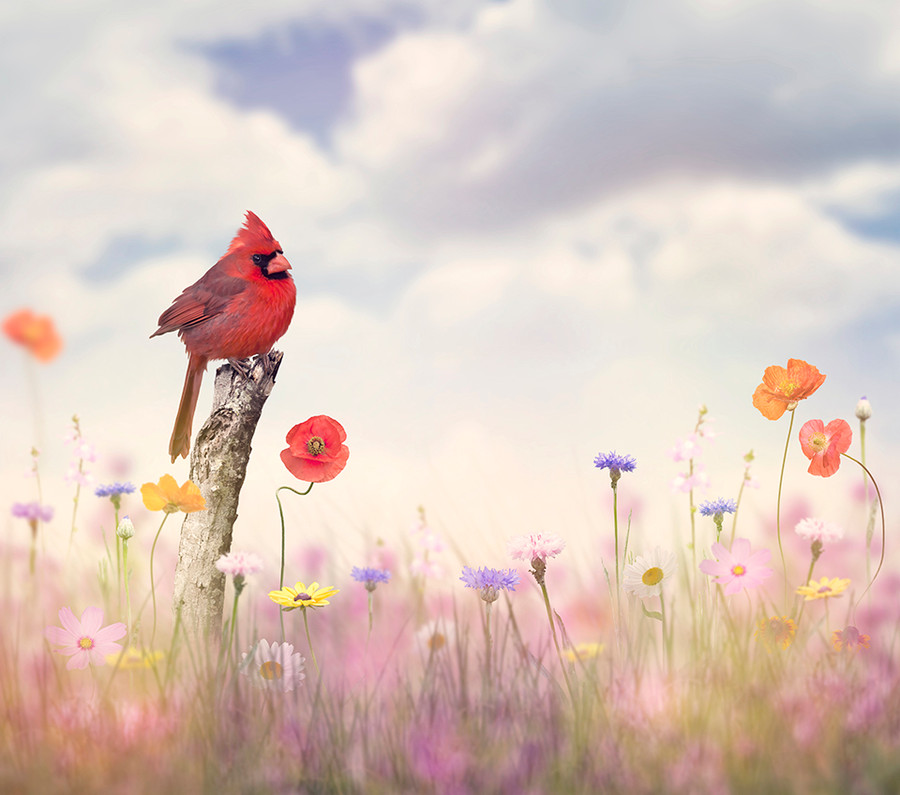My Mother’s Welcome for Visitors – Visitors With Red Wings
© Steve Lipman
Work never got done when the Finkelstein girls spotted a bird in our family’s backyard.
By the 1980s, they were no longer girls; they were married adults, and Helene was Helene Lipman (my
mother) and Henrietta was Henrietta Burgeman (aunt Hennie, Mom’s sister), but they were close as
sisters could be, and Aunt Hennie, by then divorced, was a frequent visitor at our family’s house in a
Buffalo suburb.
They would work on all sorts of chores together. Until they noticed a bird, especially a brightly colored
one, in our small, grassy backyard.
If Mom or Aunt Hennie saw a bluebird or a cardinal, they’d put down the bowl of dough they were
stirring, the dishes they were drying, or whatever they were putting in the oven.
It was showtime, and the performers had wings and feathers.
Mom and Aunt Hennie were especially fond of cardinals. Which Mom and Aunt Hennie would watch as
long as the birds stayed within sight, offering free entertainment.
Backyard birdwatchers?
As a bookworm, as a city boy (like Mom, I am a native of Buffalo, and have lived in New York City 42
years), I never understood the fascination that some people have for watching birds – in a forest, in
places like Central Park, or, in the case of my mother and my aunt, in our family’s backyard – but it’s a
harmless, inexpensive, and potentially educational, pastime.
And, G-d-willing, it teaches the participants sensitivity, and respect, for part of G-d’s animal kingdom.
Birdwatchers, after all, approach their avocation with binoculars or sketchpad in hand – not rifle or
crossbow; birdwatchers come to observe, not consume, the objects of their fascination.
Like Mom and Aunt Hennie.
They would usually keep the shades up on the kitchen’s back window so they wouldn’t miss a cardinal
perching on the branches of one of the backyard trees. I don’t think the cardinals built a nest in those
trees, so an occasional visit was a special occasion.
An alternative term for birdwatching, I learned, is “birding,” but Mom (also a dedicated-and-moderately-
successful back yard gardener) never rose to that level; too busy raising a family, she didn’t have the
time – or the inclination – to buy a set of binoculars or to go traipsing into the woods with other
“birders.” For Mom, it was a casual, passive, part-time (but engaging) hobby – she’d spy birds when they
came to her.
Which they did, regularly, but less regularly than robins, New York’s state bird.
Why cardinals?
I never asked. Mom, who died at 104 in early August, probably took to them because they are beautiful,
and easy to spot. And are not predators. (And they are the official state birds of seven states in the U.S.)
It wasn’t just cardinals. Mom would throw bread crumbs to the ducks and geese who populated the
lakeside area of the apartment in Sugar Land, near Houston, where she lived after she left Buffalo in
2006.
Everyone who knew Mom knew the special place that cardinals held in her heart.
First in the living room of her new apartment, then in her room in an assisted living facility where she
spent her last year, Mom housed a collection of cardinal paraphernalia, given to her by friends and
relatives – cardinal photographs, wooden cardinal carvings, acrylic cardinal ornaments, every sort of
creative cardinal reminder. Her living space became a sanctuary for cardinals – without the droppings.
Seeing that Mom missed her bird sightings after she settled in Texas, and that she had a lot of free time
at her assisted living residence (diminishing eyesight made reading books or newspaper articles a chore,
and she had little interest in the card games or arts-and-crafts activities that amused fellow residents),
my sister thoughtfully ordered a pair of clear bird feeders, several inches across, which would hold a
small pile of sunflower seeds and other seeds that were designed to keep birds acomin’. My sister
affixed the bird feeders with suction cups to the outside of one of Mom’s windows, facing a sunny
courtyard whose towering trees attracted a host of avian residents.
An inexpensive investment in a loved one’s mental health.
Mom could watch the birds, for long stretches of time, without leaving her room.
The bird feeders did their intended job; they fed birds – and offered Mom chirping company.
“Can you call Mom?” my sister, busy at work, asked me on the phone one day. “There are birds outside
her window, and she can talk about them for 20 minutes.”
I called Mom. I got a play-by-play description of the birds – their number, their size, their behavior, and
especially their color. The bird feeders, fortunately, had attracted some cardinals.
A great day for Mom.
Mom chose well (perhaps not coincidentally, the sports nickname of the graduate school I attended is
the cardinals).
Cardinals are a songbird native to the Americas.
A cardinal:
• Is very adaptable to various habitats.
• Sheds its old feathers annually and grows new ones.
• Is largely monogamous, and the male of the species will bring food to his mate who is sitting on
the nest.
While a cardinal has no specific spiritual symbolism in the lore of Judaism, our family’s faith, mystics
commonly depict one’s arrival as a sign from a departed love one or an angelic presence.
So we made sure that Mom would not run out of crimson-colored warblers.
While I was in Sugar Land, during my frequent jaunts to Texas to see her, I would every day replenish
Mom’s supply of seeds from a large bagful of them stored in her room; otherwise, my sister would
handle the responsibility.
The birds never went hungry.
Which made Mom happy; they brought a smile to her face, and she made sure that her children brought
them daily nourishment.
It was an easy form of chesed, the practice of kindness – in this case, to G-d’s winged creations --that our
tradition encourages.
Mom was happy to see any birds occupying the feeders, albeit for short periods, but the cardinals gave
her special joy. They were familiar company, animated, more interesting than anything on her wall-
mounted large TV screen.
Mom was not alone in her personal avocation. She had the support of science:
“Birdwatching works in a house, an apartment, or a care suite. Birds appear every day, so each visit feels
like a tiny gift. This low-impact exercise adapts to your abilities and supports balance, coordination, and
emotional wellbeing,” according to seniorsafetyadvice.com. “Cornell researchers report that ten
minutes of noticing birds can drop anxiety scores by twenty percent and raise mood for the rest of the
day.”
Not coincidentally, the northern cardinal ranks first on the website’s list of birds favored by seniors for
watching.
That’s what Mom saw at her window.
When her health declined, Mom spent a few weeks at a skilled nursing/rehabilitation center a few miles
from her assisted living facility. For some fresh air, Mom would often wheel herself outside the center’s
back door – where she could see, painted on the wall of a row of small stores across the street, the
three-foot-wide image of (you guessed it!) a cardinal.
Which is not a surprise there ...
The Northern Cardinal (cardinalis cardinalis) ranks among the most-frequently-spotted birds in Texas’
Fort Bend County, where Sugar Land in located. (Only the male of the species sports the distinctive
chromatic plumage, so dominant-grey or tawny-brown female cardinals may also have been pecking on
the seeds at the feeders at Mom’s window, but she and I, neither of us ornithologists, would not have
known it.)
Back at assisted living, if Mom was not watching the action in the courtyard outside her windows, the
fluttering of birds’ wings would announce their arrival.
Mom would beam when the cardinals showed up; it was like being back in Buffalo; it was a break from
the monotony of life in the assisted living facility, where the administration scheduled intermittent
periods of activities during the day, like age-appropriate exercise classes (many of the participants
showed up in wheelchairs) and sing-alongs (mostly tunes about a century old), to fill the residents’ days.
Like their winged cousins of various species, the cardinals would typically swoop in, often in pairs, often fighting for space in the tight plexi-glass quarters, grab a few morsels with their red-orange beaks, often spilling many of the seeds onto the patch of grassy ground underneath the feeders, then fly off, as quickly as they had arrived.
These few minutes brightened Mom’s entire day – even as the encroachment of dementia steadily robbed her old personality.
As far as I know, Mom was the only resident of the assisted living facility who had her own bird feeder outside her window; she was delighted when the young aides who came in frequently – to give her her daily pills, help her get dressed, and simply make sure that she was OK – shared her enthusiasm for the free entertainment that nature generously provided.
The bird feeders were also a hit with their intended “customers.”
In the weeks before Mom died, in Texas’ sunny summer, the plexi-glass units were usually filled – with apparently ravenous birds, my sister told me.
“Most of them were cardinals.”
About the Author
A resident of Forest Hills, Queens, and a freelance writer, Steve Lipman was on the staff of the Jewish Week in New York in 1983-2020.




